Residual Strength and Drying Behavior of Concrete Reinforced with Recycled Steel Fiber from Tires
- PMID: 34683702
- PMCID: PMC8537020
- DOI: 10.3390/ma14206111
Residual Strength and Drying Behavior of Concrete Reinforced with Recycled Steel Fiber from Tires
Abstract
Fiber reinforcement of concrete is an effective technique of providing ductility to concrete, increasing its flexural residual strength while reducing its potential for cracking due to drying shrinkage. There are currently a wide variety of industrial fibers on the market. Recycled steel fibers (RSF) from tires could offer a viable substitute of industrialized fibers in a more sustainable and eco-friendly way. However, mistrust exists among users, based on fear that the recycling process will reduce the performance, coupled with the difficulty of characterization of the geometry of the RSF, as a consequence of the size variability introduced by the recycling process. This work compares the behavior of RSF from tires compared with industrialized steel or polypropylene fibers, evaluating the fresh state, compressive strength, flexural residual strength, and drying behavior. The concept of Equivalent Fiber Length (EFL) is also defined to help the statistical geometrical characterization of the RSF. A microstructural analysis was carried out to evaluate the integration of the fiber in the matrix, as well as the possible presence of contaminants. The conclusion is reached that the addition of RSF has a similar effect to that of industrialized fibers on concrete's properties when added at the same percentage.
Keywords: drying shrinkage; fiber reinforced concrete; flexural residual strength; polypropylene fibers; recycled fibers; steel fibers.
Conflict of interest statement
The authors declare no conflict of interest. The funders had no role in the design of the study; in the collection, analyses, or interpretation of data; in the writing of the manuscript, or in the decision to publish the results.
Figures















References
-
- Magnani A. Improvements Relating to the Manufacture of Fibrous Cement Sheets. No. 675,713. GB Patent. 1951 January 19;
-
- Manville J. Method of Producing Asbestos-Cement Sheets Containing Cellulosic Fiber. No. 3,344,015. U.S. Patent. 1964 August 3;
-
- Berard A. Improvement in Artificial Stone. No. 157,903. U.S. Patent. 1874 December 15;
-
- Weakley R.D. Bonding Means for Reinforced Concrete Structure. No. 1,046,913. U.S. Patent. 1912 December 10;
-
- Meischke-Smith W. Ferroconcrete Construction. No. 1,349,901. U.S. Patent. 1920 August 17;
Grants and funding
LinkOut - more resources
Full Text Sources

